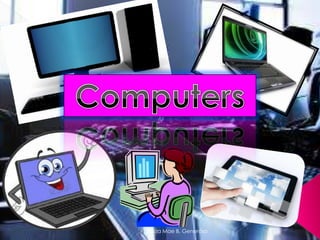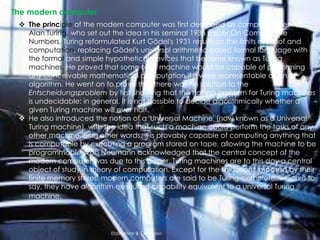The document discusses the history and development of computers. It describes how Charles Babbage conceptualized the first general-purpose mechanical computer in the early 19th century, but was unable to complete it due to technical limitations. Alan Turing later described the concept of a universal Turing machine and stored-program computer. Early computers used electromechanical relays and vacuum tubes, while later computers transitioned to using transistors and being fully electronic. Personal computers eventually emerged as smaller single-user machines based on microprocessors.








![Stored Program Computer
Early computing machines had fixed programs. Changing its
function required the re-wiring and re-structuring of the
machine.[18] With the proposal of the stored-program computer
this changed. A stored-program computer includes by design
an instruction set and can store in memory a set of instructions
(a program) that details thecomputation. The theoretical basis
for the stored-program computer was laid by Alan Turing in his
1936 paper. In 1945 Turing joined the National Physical
Laboratory and began work on developing an electronic
stored-program digital computer. His 1945 report „Proposed
Electronic Calculator‟ was the first specification for such a
device.John von Neumann at the University of Pennsylvania,
also circulated his First Draft of a Report on the EDVAC in 1945.
Elaiza Mae B. Generoso](https://image.slidesharecdn.com/elaizag-140114072814-phpapp01/85/Elaizag-9-320.jpg)
![Electronic programmable computer
Purely electronic circuit elements soon replaced their mechanical and
electromechanical equivalents, at the same time that digital calculation
replaced analog. The engineer Tommy Flowers, working at the Post Office
Research Station in Dollis Hill in the 1930s, began to explore the possible use of
electronics for the telephone exchange. Experimental equipment that he
built in 1934 went into operation 5 years later, converting a portion of
the telephone exchange network into an electronic data processing system,
using thousands of vacuum tubes.[7] In the US, John Vincent Atanasoff and
Clifford E. Berry of Iowa State University developed and tested the Atanasoff–
Berry Computer (ABC) in 1942,[16] The first electronic digital calculating
device.[17] This design was also all-electronic and used about 300 vacuum
tubes, with capacitors fixed in a mechanically rotating drum for memory.
Elaiza Mae B. Generoso](https://image.slidesharecdn.com/elaizag-140114072814-phpapp01/85/Elaizag-10-320.jpg)

